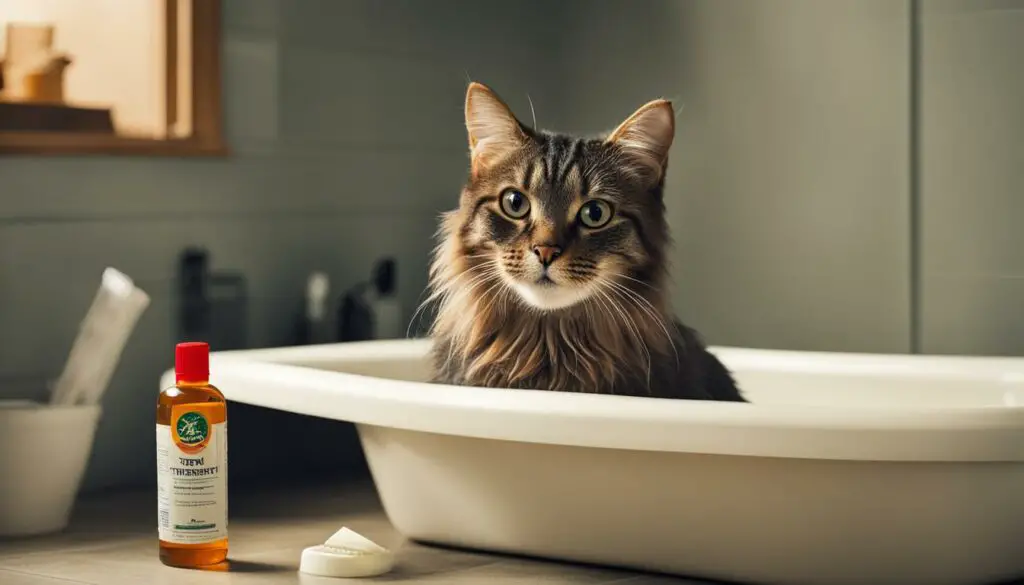Fleas are tiny parasitic insects that can cause intense itching and skin irritation in cats. They can also transmit diseases to both cats and humans. While bathing can help remove fleas from your cat’s fur, it is not always necessary before flea treatment. The decision to bathe your cat before flea treatment will depend on your cat’s individual needs and preferences, as well as the type of flea control product you are using. It is best to consult with your veterinarian to determine the most appropriate course of action.
Key Takeaways:
- Bathing your cat before flea treatment is not always necessary. Consult with your veterinarian for the best course of action.
- Fleas can cause intense itching, skin irritation, and transmit diseases to both cats and humans.
- Implement comprehensive flea control measures, including regular combing, appropriate flea prevention treatments, and thorough treatment of the home and yard.
- Consistency in flea control is essential for maintaining a flea-free environment and ensuring the health and well-being of your cat.
Understanding Fleas and Their Impact on Cats
Fleas are a common nuisance for cats, causing itching, discomfort, and potentially transmitting diseases. Understanding the impact of fleas on cats is crucial for effective flea control and maintaining your cat’s health and well-being.
Cat fleas: Cat fleas (Ctenocephalides felis) are the most common type of fleas found on cats. They are small, wingless insects that feed on the blood of cats, causing intense itching and irritation. When a flea bites a cat, it injects saliva into the skin, which can lead to hypersensitivity reactions and allergic dermatitis.
“Flea infestations can cause a range of issues in cats, including hair loss, skin infections, and anemia.”
Flea infestations: Fleas multiply rapidly, with a single female flea capable of laying up to 50 eggs per day. These eggs fall off the cat’s fur and can infest the environment, including carpets, bedding, and furniture. The eggs hatch into larvae, which feed on organic matter before progressing into pupae and eventually becoming adult fleas. Fleas can survive for extended periods in the environment, making it essential to address both the cat and the home to eradicate fleas completely.
Flea-borne diseases: In addition to causing discomfort, fleas can transmit diseases to both cats and humans. Some common flea-borne diseases include cat scratch disease, bartonellosis, and hemotropic mycoplasmosis. These diseases can have serious consequences for the health of cats, making flea control a crucial aspect of overall cat care.

| Signs of Fleas on Cats | Flea Prevention and Control Measures |
|---|---|
|
|
By understanding the impact of fleas on cats and implementing appropriate flea control measures, you can help protect your cat from the discomfort and potential health risks associated with flea infestations. Consult with your veterinarian to determine the best flea prevention and control plan for your cat.
Factors Contributing to Flea Infestations in Cats
When it comes to flea infestations in cats, there are several factors that can contribute to the problem. These factors include whether your cat spends time outdoors or indoors, the surrounding environment, and the presence of neighboring flea problems. Understanding these factors can help you take the necessary precautions to protect your cat from fleas.
Outdoor Cats
Cats that spend time outdoors are more likely to encounter fleas in their natural environment. The outdoors provide numerous opportunities for cats to come into contact with fleas, whether it’s through wildlife, other infested animals, or flea-ridden environments. Therefore, outdoor cats have a higher risk of attracting fleas.
Moist and Wooded Surroundings
Moist and wooded surroundings can also increase the chances of a cat attracting fleas. Fleas thrive in warm and humid environments, and areas with dense vegetation provide ideal conditions for them to breed and infest. If your cat regularly roams in such areas, the risk of flea infestation is heightened.
Long Grass
Long grass can harbor fleas and provide a hiding place for them to latch onto your cat. When a cat passes through long grass, fleas can easily jump onto its fur and start an infestation. Cutting the grass short and regularly maintaining your yard can help reduce the presence of fleas.
Indoor Flea Infestations
Even indoor cats can attract fleas from other sources. If you have other pets in the house, such as dogs, they can bring fleas inside and potentially infest your cat. Additionally, neighboring flea problems can also contribute to flea infestations in indoor cats. Fleas can easily jump from one place to another, so if your neighbor’s pets have fleas, there is a possibility of them finding their way into your home.
By being aware of these contributing factors, you can take steps to prevent and address flea infestations in your cat. Regular flea prevention treatments, keeping your cat’s environment clean, and consulting with your veterinarian for guidance are essential in protecting your cat from fleas and ensuring their overall well-being.
The Importance of Flea Control for Cats
Flea control is crucial for the health and well-being of our feline friends. It not only helps prevent discomfort and skin irritation but also reduces the risk of flea-borne diseases. To effectively control fleas, it is essential to understand the importance of flea preventatives, the recommended duration of flea treatment, the significance of year-round prevention, and the specific considerations for multi-pet households.
The Role of Flea Preventatives
Flea preventatives are specially formulated products designed to eliminate and prevent flea infestations in cats. There are various types of flea preventatives available, including topical treatments, oral medications, and flea collars. These products work by targeting different stages of the flea life cycle, preventing the development and reproduction of fleas.
Using flea preventatives regularly as recommended by your veterinarian can help break the flea life cycle, ensuring that your cat remains flea-free and protected from potential health risks. It is important to choose an appropriate flea preventative based on your cat’s age, weight, and overall health, as well as follow the recommended dosage and application instructions.
Duration of Flea Treatment
While most flea preventatives are labeled for once-monthly use, it is essential to continue flea treatment for a minimum of three to four months. This duration ensures thorough eradication of fleas and prevents reinfestation. It is important to complete the full course of treatment, even if you no longer see fleas on your cat, as there may still be flea eggs or dormant pupae in the environment that can hatch later.
Year-Round Prevention and Multi-Pet Households
Fleas can be a persistent problem, especially in multi-pet households or areas with a high flea population. Year-round prevention is often recommended to maintain effective flea control and prevent infestations. This is particularly important if your cat has a history of flea problems or shares the living space with other pets, as fleas can easily spread from one animal to another.
By implementing year-round prevention measures, such as consistently using flea preventatives and regularly treating the home and yard, you can create a flea-free environment and ensure the long-term health and well-being of your cat.
Remember, flea control is not a one-time task but an ongoing commitment. By understanding the importance of flea preventatives, following the recommended duration of treatment, and implementing year-round prevention measures, you can effectively protect your cat from fleas and provide them with a healthier, happier life.
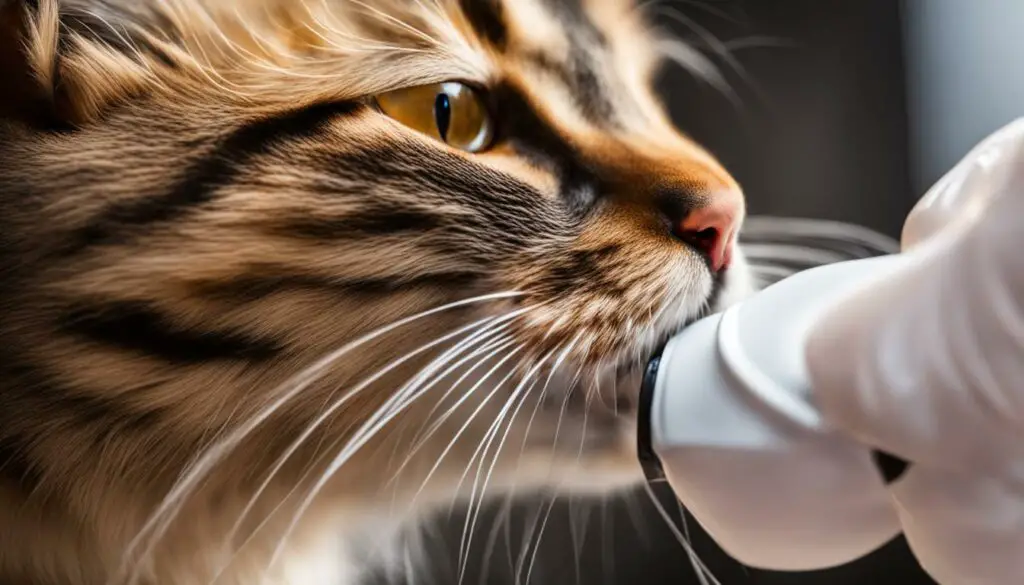
Bathing as a Part of Flea Treatment Process
Bathing can be a beneficial component of the flea treatment process as it helps to remove fleas from a cat’s fur. However, it is not always necessary before flea treatment, and it is important to consider other factors when deciding whether to bathe your cat. The primary focus should be on using appropriate flea control products as recommended by your veterinarian.
While bathing can help reduce the flea population on your cat, it is essential to use effective flea control products to address the infestation fully. These products come in various forms, such as topical treatments, oral medications, or flea collars. Your veterinarian can guide you in selecting the most suitable product based on your cat’s needs and the severity of the flea infestation.
It is important to note that not all cats tolerate bathing, and forcing them into a bath can cause distress. If your cat finds bathing stressful, there are alternative methods for flea control, such as using pet wipes or dry shampoos specifically designed for cats. Regular grooming, including brushing, can also help remove fleas and prevent infestations.
Ultimately, the decision to bathe your cat before flea treatment should be based on their individual needs and preferences, as well as the guidance of your veterinarian. The primary goal is to eliminate fleas and provide your cat with effective, long-lasting flea control to ensure their health and well-being.
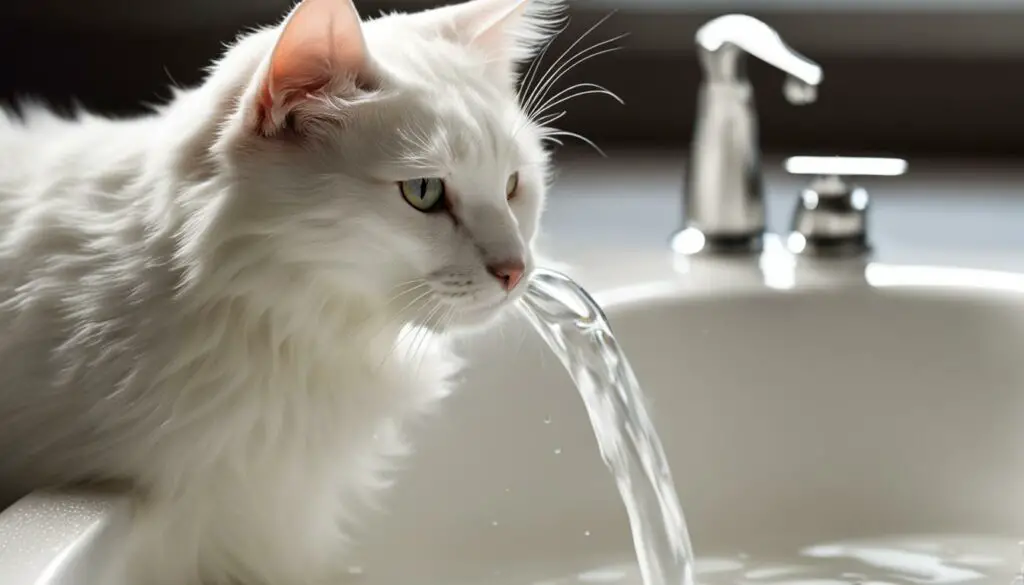
Table: Pros and Cons of Bathing for Flea Control
| Pros | Cons |
|---|---|
| Helps remove fleas from the cat’s fur | Not all cats tolerate bathing |
| Can reduce the flea population on the cat | Forcing a cat into a bath can cause distress |
| Complements the use of flea control products | May not be necessary before flea treatment |
| Can be a part of regular grooming routine | Some cats may develop a negative association with bathing |
Best Practices for Bathing Cats
Bathing a cat can be a challenging task, as many cats are naturally averse to water. However, with the right approach and some patience, you can help your cat become more comfortable with baths. Here are some tips to make the bathing experience easier for both you and your feline friend:
1. Getting Cats Comfortable with Baths
To help your cat become more comfortable with baths, start by introducing them to the bathing process gradually. Begin by letting your cat explore the bathroom and get used to the sounds and sensations associated with bathing. You can also consider using treats, praise, or play to create positive associations with bath time. Always respect your cat’s boundaries and never force them into a bath if they are clearly distressed.
2. Cat Bath Supplies
It’s important to have all the necessary bath supplies ready before you start bathing your cat. This includes a cat-safe shampoo, a non-slip mat for the bathtub or sink, towels, and a brush or comb for grooming after the bath. Make sure the shampoo you use is specifically formulated for cats and avoid using human or dog shampoos, as they can be too harsh for feline skin.
3. Cat Grooming Tips
Before bathing your cat, it’s a good idea to trim their nails to prevent scratching. Use a specialized cat nail trimmer and be careful not to cut too close to the quick. During the bath, speak in a calm and reassuring tone to help keep your cat relaxed. Gently wet the fur, avoiding the face and ears, and lather the shampoo according to the product’s instructions. Rinse thoroughly and dry your cat with a towel, taking care to avoid any cold drafts. Finally, reward your cat with treats or play to reinforce positive behavior and make the experience more enjoyable for them.
Remember, bathing may not be necessary for all cats before flea treatment. It’s best to consult with your veterinarian to determine the most appropriate course of action based on your cat’s individual needs and preferences. By following these best practices and being patient with your cat, you can help make bath time a more positive and stress-free experience.

Alternatives to Bathing for Flea Control
While bathing can be an effective way to remove fleas from your cat’s fur, it’s not always practical or feasible for every cat. If your cat is not comfortable with bathing or if you prefer alternatives to bathing, there are other options available for flea control.
Pet Wipes
Pet wipes are a convenient option for cleaning your cat’s fur and removing fleas. These pre-moistened wipes are designed specifically for use on pets and can effectively remove dirt, debris, and fleas from your cat’s coat. Simply wipe down your cat, paying close attention to areas where fleas are commonly found, such as the neck, back, and tail.
Dry Shampoo
Dry shampoos formulated for cats can be an excellent alternative to bathing. These powder or foam-based products can be applied to your cat’s fur, gently massaged in, and then brushed out. Dry shampoos not only help control fleas but also leave your cat’s coat looking fresh and clean.
Regular Grooming
Regular grooming is an essential part of flea prevention. Brushing your cat’s fur regularly can help remove fleas, flea dirt, and other debris. Additionally, grooming allows you to inspect your cat’s coat for any signs of flea infestation or skin irritation. Use a flea comb to comb through your cat’s fur, paying close attention to areas where fleas commonly hide, such as the base of the tail and behind the ears.
Remember, it’s important to consult with your veterinarian before using any flea control products on your cat. They can provide guidance on the most suitable alternatives to bathing and recommend the best flea control approach for your cat’s specific needs.
Treating Fleas in the Home
To effectively eliminate fleas in your home, it is important to address both the cat and the home environment. Treating the cat alone is not enough, as fleas can quickly reproduce and infest the home again.
The first step in treating fleas in the home is to wash all bedding thoroughly. Fleas and their eggs can hide in the bedding, so it is crucial to use hot water and detergent to kill them. Dry the bedding on high heat to ensure any remaining fleas are eliminated.
Vacuuming is another essential step in flea control. Vacuum all carpets, rugs, and upholstered furniture, paying extra attention to areas where your cat spends the most time. Empty the vacuum bag or canister outside immediately after vacuuming to prevent fleas from re-infesting your home.
In addition to washing and vacuuming, steam-cleaning can be an effective method to kill fleas and their eggs. Steam can penetrate deep into carpets and upholstery, reaching the areas where fleas hide. Make sure to follow the manufacturer’s instructions when using a steam cleaner and focus on high-risk areas, such as your cat’s favorite resting spots.
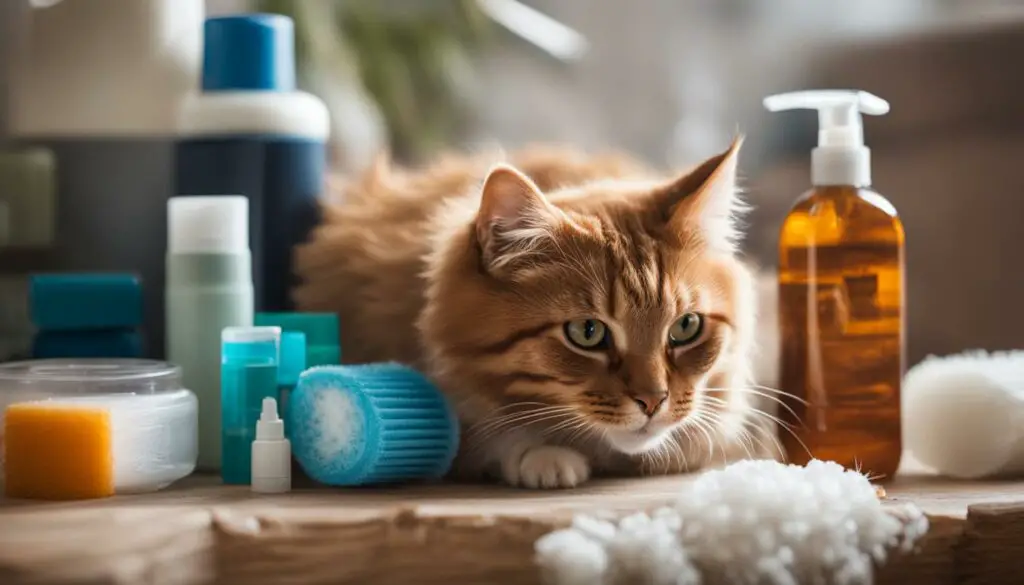
Ensuring Complete Flea Eradication
When dealing with heavy flea infestations, a multifaceted approach is crucial to ensure complete eradication. It’s not enough to simply treat your cat; you must also address the entire household. This includes treating all household pets, as fleas can easily spread among them. Additionally, it’s important to recognize that fleas can transmit diseases, such as flea-borne illnesses and anemia, both to your pets and to humans.
To effectively eliminate fleas, it’s essential to follow through with the recommended steps for complete eradication. This includes treating all household pets with appropriate flea control products, as well as thoroughly cleaning and treating the home and yard. A combination of flea prevention treatments, environmental control, and potential veterinary intervention for flea-related diseases is necessary to ensure a flea-free environment.
By taking a comprehensive and consistent approach to flea control, you can protect both your pets and your family from the harmful effects of fleas. Regular check-ups with your veterinarian can provide guidance on the most suitable flea control measures for your specific situation. Remember, consistency is key in maintaining a flea-free environment and safeguarding the health and well-being of your furry friends.

| Flea Eradication Steps | Importance |
|---|---|
| Treat all household pets | Prevents fleas from spreading among pets |
| Clean and treat the home | Eliminates fleas at all life stages |
| Thoroughly treat the yard | Prevents reinfestation from outdoor sources |
| Implement regular flea prevention | Maintains a flea-free environment |
| Seek veterinary treatment if needed | Addresses flea-related diseases or anemia |
Flea Prevention for Long-Term Control
In order to maintain long-term control of fleas, it is important to prioritize year-round prevention, especially for those living in multi-pet households. Consistent use of flea prevention products is key to preventing infestations and safeguarding your cat’s health. It is crucial to choose the appropriate flea prevention method for your cat and carefully follow the recommended dosage and application instructions. Regular check-ups with your veterinarian can help ensure that your cat’s flea prevention measures are effective and suitable for their individual needs.
In multi-pet households, it is important to treat all pets for fleas, even if they do not show signs of infestation. This helps prevent fleas from spreading among the pets and ensures comprehensive protection. Fleas can easily pass from one pet to another, so it is important to address flea prevention for all furry family members.
Recommended Flea Prevention Products
When it comes to flea prevention products, there are several options available. Topical treatments, such as spot-on treatments applied directly to the skin, are a popular choice. These products are typically applied once a month and provide long-lasting protection against fleas. Another option is flea collars, which are worn around the cat’s neck and continuously release flea-repelling chemicals. It is important to choose a flea prevention product that is specifically formulated for cats, as dog flea products may contain ingredients that are toxic to cats.
Additionally, it is essential to maintain a clean and hygienic environment for your cat. Regular vacuuming of carpets, upholstery, and bedding can help remove flea eggs, larvae, and pupae from the home. Washing bedding and other fabric items in hot water can also help eliminate fleas. If necessary, you may consider using insecticides or seeking professional pest control services to ensure thorough treatment of the home and yard.
| Flea Prevention Products | Description |
|---|---|
| Topical Treatments | Spot-on treatments applied directly to the skin, providing long-lasting protection against fleas. |
| Flea Collars | Collars worn around the cat’s neck that release flea-repelling chemicals continuously. |
| Oral Medications | Pills or tablets that are ingested by the cat, providing systemic protection against fleas. |
| Sprays | Liquid sprays that can be applied directly to the cat’s fur for immediate flea control. |
By prioritizing year-round flea prevention, treating all pets, and maintaining a clean environment, you can effectively control fleas and ensure the health and well-being of your cat. Remember to consult with your veterinarian to determine the most suitable flea prevention method for your cat and stay consistent in your preventive measures.
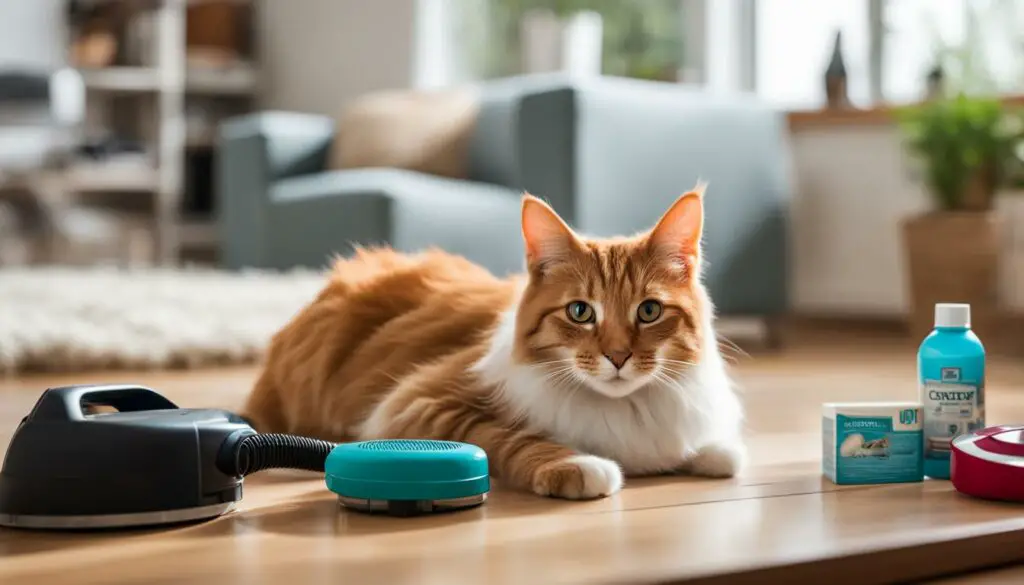
Flea Control and Human Safety
Fleas not only affect cats but also pose a risk to humans. They can transmit diseases such as plague, typhus, and mycoplasma. When using flea control products, it is important to follow the instructions carefully to ensure the safety of your cat and yourself. Avoid using dog flea products on cats, as they may contain ingredients that are toxic to cats. If you have any concerns about the safety of flea control products, consult your veterinarian for guidance.
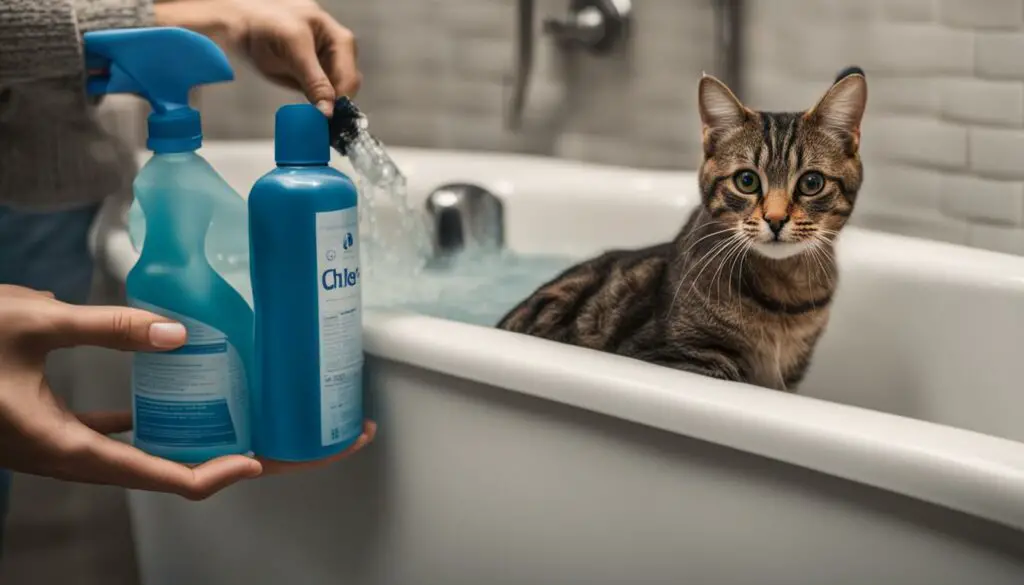
The Importance of Human Safety in Flea Control
While it is crucial to prioritize the health and well-being of your cat when it comes to flea control, it is equally important to consider the safety of humans in your household. Fleas can transmit diseases to humans, and certain flea control products may contain chemicals that can be harmful if not used correctly. By following the instructions provided with flea control products, you can ensure that you are effectively managing fleas while minimizing any risks to yourself and your loved ones.
| Flea Control and Human Safety | Key Points |
|---|---|
| 1 | Follow instructions: carefully read and follow the instructions provided with flea control products to ensure safe and effective use. |
| 2 | Avoid using dog flea products on cats: dog flea products may contain ingredients that are toxic to cats. Use only cat-specific flea control products. |
| 3 | Consult your veterinarian: if you have any concerns or questions about the safety of flea control products, seek guidance from your veterinarian. |
Remember, the goal of flea control is to protect the health and well-being of your cat and your family. By taking necessary precautions and using appropriate flea control products, you can effectively manage fleas while prioritizing human safety.
Recognizing the Signs of Fleas on Cats
When it comes to the well-being of our feline companions, it’s crucial to be able to recognize the signs of a flea infestation. While these tiny parasites may be difficult to spot at first, their presence can cause significant discomfort for cats. Keep an eye out for common signs such as excessive itching and scratching, hair loss, and skin irritation. Cats may also exhibit behavioral changes, such as biting at their fur or overgrooming in an attempt to alleviate the discomfort caused by fleas. Additionally, the presence of small black specks, known as flea dirt, in your cat’s fur is a telltale sign of fleas.
To effectively address a flea infestation, it’s important to take prompt action. Start by combing your cat’s fur with a flea comb, paying close attention to areas like the neck, back, and tail. This can help remove adult fleas and flea dirt, giving you a better idea of the extent of the infestation. If you notice any signs of fleas, it’s essential to seek appropriate flea control measures from your veterinarian. They can recommend suitable flea treatments and preventive products that are safe and effective for your cat.
It’s important to note that flea infestations can not only cause discomfort for your cat but also pose health risks. Fleas can transmit diseases and parasites, such as tapeworms, to cats. Moreover, prolonged exposure to fleas can lead to complications such as anemia due to blood loss. Therefore, early detection and proactive flea control are vital for maintaining your cat’s health and well-being.
| Signs of Fleas on Cats | Indicators |
|---|---|
| Excessive itching and scratching | Cats may scratch excessively, often focusing on specific areas. |
| Hair loss | Infested cats may experience thinning hair or bald spots. |
| Skin irritation | Fleas can cause redness, swelling, and irritations on the skin. |
| Biting at the fur | Cats may bite or chew at their fur in response to flea bites. |
| Overgrooming | Some cats may excessively groom themselves to alleviate itching. |
Flea infestations can be uncomfortable for cats and may lead to health issues if left untreated. Recognizing the signs of fleas, such as excessive itching, hair loss, and skin irritation, is crucial for timely intervention. If you suspect that your cat has fleas, consult with your veterinarian for appropriate flea control measures and preventive treatments.
Understanding the Flea Life Cycle
Understanding the flea life cycle is crucial for effective flea control. Fleas go through four distinct stages in their life cycle: eggs, larvae, pupae, and adult fleas. Each stage plays a role in the infestation and requires targeted treatment to eliminate the pests completely.
The life cycle begins when adult female fleas lay eggs on the host animal or in the surrounding environment. These tiny white eggs are not easily visible and can fall off your cat, ending up in carpets, bedding, or furniture. The eggs hatch into larvae, which are worm-like and feed on organic matter, including flea feces and skin debris.
After the larvae feed and grow, they enter the pupal stage, where they form a protective cocoon. Pupae can remain dormant for weeks or even months, making them resistant to most forms of treatment. Finally, adult fleas emerge from the cocoons when they sense vibrations, carbon dioxide, or body heat, signaling the presence of a potential host.

| Stage | Description | Treatment |
|---|---|---|
| Eggs | Tiny white eggs laid by adult female fleas | Regular vacuuming and washing of bedding |
| Larvae | Worm-like larvae that feed on organic matter | Regular vacuuming and use of insect growth regulators |
| Pupa | Cocooned stage where larvae develop into adult fleas | Application of insecticides and thorough cleaning of the environment |
| Adult Fleas | Fully developed fleas capable of reproducing | Regular use of flea control products on pets and treating the environment |
To effectively control fleas, it is necessary to target all stages of the flea life cycle. This includes treating your cat with a suitable flea control product that kills adult fleas, using insect growth regulators to prevent larvae from developing, and regularly cleaning your home and pet’s environment to eliminate eggs and pupae. Consistency is key in flea control to break the life cycle and prevent reinfestation.
Steps to Get Rid of Fleas on Cats
To effectively get rid of fleas on cats, it is important to follow a comprehensive approach that includes flea combing, flea bathing, flea prevention, and treating the home and yard. Here are the steps to take:
Flea Combing
Start by using a flea comb to comb through your cat’s fur. This will help remove adult fleas and their eggs. Make sure to comb in the direction of hair growth, paying attention to areas like the neck, belly, and tail. Dip the comb in soapy water after each stroke to drown any fleas that may be caught.
Flea Bath
If your cat is comfortable with bathing, you can give them a flea bath using a cat-specific flea shampoo. Follow the instructions on the shampoo bottle and make sure to thoroughly lather your cat’s fur, paying special attention to hard-to-reach areas. Rinse your cat thoroughly and dry them with a warm towel.
Flea Prevention
After flea combing and bathing, it is important to use a flea prevention product recommended by your veterinarian. This can include topical treatments, oral medications, or flea collars. Follow the instructions on the product carefully and make sure to apply or administer the treatment regularly as directed.
Treating the Home and Yard
To eliminate fleas from your home and yard, it is important to take thorough measures. Vacuum all carpets, upholstery, and bedding, paying special attention to areas where your cat spends the most time. Wash your cat’s bedding and any other washable items in hot water. Use an appropriate insecticide or hire professional pest control services to treat your home and yard, especially areas where fleas may hide, such as cracks, crevices, and outdoor resting areas.
By following these steps and maintaining a consistent flea control routine, you can effectively get rid of fleas on your cat and create a flea-free environment for their health and well-being.
The Importance of Consistency in Flea Control
When it comes to flea control for cats, consistency is key. Whether you choose to bathe your cat before flea treatment or not, it is important to implement a comprehensive approach to keep fleas at bay. This includes regular combing to remove fleas and flea dirt, appropriate flea prevention treatments, and thorough treatment of the home and yard.
Consistency is especially crucial when it comes to recurring flea treatment. It is essential to treat all pets in the household, even those that show no signs of infestation. This prevents fleas from spreading among pets and helps maintain a flea-free environment. Additionally, repeat home treatment is necessary to ensure any remaining fleas are eliminated and to prevent reinfestation.
Long-term prevention is another key aspect of flea control. Using flea prevention treatments year-round, especially in multi-pet households, helps protect your cat’s health and prevent future infestations. Regular check-ups with your veterinarian can ensure that your flea control measures are effective and appropriate for your cat’s specific needs.
Treating All Pets
When it comes to flea control, treating all pets in the household is crucial. Even if one pet shows no signs of fleas, they can still act as carriers and spread fleas to other pets. Treating all pets helps prevent the cycle of fleas from continuing and ensures that all pets are protected.
Repeat Home Treatment
Eliminating fleas from your home requires repeat treatment. Flea eggs can hide in carpets, bedding, and furniture, waiting to hatch and start the cycle again. Regular vacuuming, washing bedding, and using insecticides or professional pest control services can help ensure complete flea eradication and a flea-free environment.
Long-Term Prevention
To maintain long-term control of fleas, it is important to implement year-round prevention measures. Using flea prevention treatments consistently throughout the year helps prevent infestations and protects your cat’s health. Consult with your veterinarian to determine the most suitable flea prevention method for your cat.
| Key Points |
|---|
| Treat all pets in the household for fleas, even if they show no signs of infestation. |
| Repeat home treatment, including vacuuming, washing bedding, and using insecticides. |
| Implement long-term prevention measures, such as year-round flea prevention treatments. |
Conclusion
When it comes to flea treatment for cats, the decision to bathe them before treatment depends on several factors. It is important to consider your cat’s individual needs and preferences, as well as the type of flea control product you are using. While bathing can help remove fleas from your cat’s fur, it may not always be necessary.
Consulting with your veterinarian is the best way to determine the most appropriate course of action for your cat. They can provide expert advice tailored to your cat’s specific needs. Whether you choose to bathe your cat or not, it is crucial to implement comprehensive flea control measures.
This includes regular combing to remove fleas, using appropriate flea prevention treatments, and addressing the home and yard for complete eradication. Consistency is key in flea control to maintain a flea-free environment and ensure the health and well-being of your cat.
FAQ
Should I bathe my cat before flea treatment?
The decision to bathe your cat before flea treatment will depend on your cat’s individual needs and preferences, as well as the type of flea control product you are using. It is best to consult with your veterinarian to determine the most appropriate course of action.
What are the signs of fleas on cats?
Common signs of fleas on cats include frequent itching and scratching, biting at the skin or fur, overgrooming, hair loss, and skin irritation. The presence of flea dirt, small black specks in the fur, is also an indicator of fleas.
How can I get rid of fleas on my cat?
To get rid of fleas on cats, start by combing their fur with a flea comb to remove as many fleas as possible. If necessary, give your cat a flea bath using an appropriate shampoo for flea control. Follow up with regular flea prevention treatments as recommended by your veterinarian.
What should I do to prevent future flea infestations?
To prevent future flea infestations, it is important to treat all pets in the household for fleas, even those that do not show signs of infestation. Repeat treatment of the home and yard is also necessary to eliminate any remaining fleas and prevent reinfestation. Long-term prevention measures, such as year-round flea prevention treatments, should be implemented.
Are there alternatives to bathing for flea control?
If your cat is not comfortable with bathing or if it is not practical to bathe them, there are alternatives to consider for flea control. Pet wipes can be used to clean your cat’s fur and remove fleas without the need for a full bath. Dry shampoos designed specifically for cats can also be used to help control fleas.
How can I make bathing my cat more comfortable?
Bathing can be a challenging task for many cats, but with patience and proper technique, you can help your cat become more comfortable with baths. Trim your cat’s nails before bathing to prevent scratching and introduce them to the bathing process gradually. Use positive reinforcement, such as treats or play, to make the experience more enjoyable.
How can I treat fleas in my home?
To effectively eliminate fleas in your home, wash all bedding thoroughly, vacuum carpets and upholstery, and consider steam-cleaning to kill any remaining flea eggs. While chemical flea treatments in the home are not always necessary, your veterinarian can recommend appropriate products if you choose to use them.
What is the importance of consistency in flea control?
Consistency is key in flea control to prevent future infestations. It is important to treat all pets in the household for fleas, repeat treatment of the home and yard, and implement long-term prevention measures. Regular check-ups with your veterinarian can ensure that your flea control measures are effective and appropriate for your cat’s specific needs.
How do fleas impact cats and humans?
Fleas can cause various issues in cats, including intense itching, hair loss, and skin infections. They can also transmit diseases to both cats and humans. It is important to address flea infestations promptly to prevent further discomfort and potential health issues for your cat.
How long do flea preventatives for cats last?
Most flea preventatives are labeled for once-monthly use, but it is recommended to use flea prevention for three to four months minimum to effectively eliminate a flea problem. Year-round prevention is often advised, especially for cats with a history of fleas or in multi-pet households.
Are flea control products safe for cats and humans?
When using flea control products, it is important to follow the instructions carefully to ensure both the safety of your cat and yourself. Avoid using dog flea products on cats, as they may contain ingredients that are toxic to cats. If you have any concerns about the safety of flea control products, consult your veterinarian for guidance.
Source Links
- https://www.thesprucepets.com/fleas-and-your-cat-552346
- https://www.preventivevet.com/cats/giving-a-cat-a-bath-why-and-how
- https://be.chewy.com/help-my-cat-has-fleas-signs-treatment-and-prevention/

